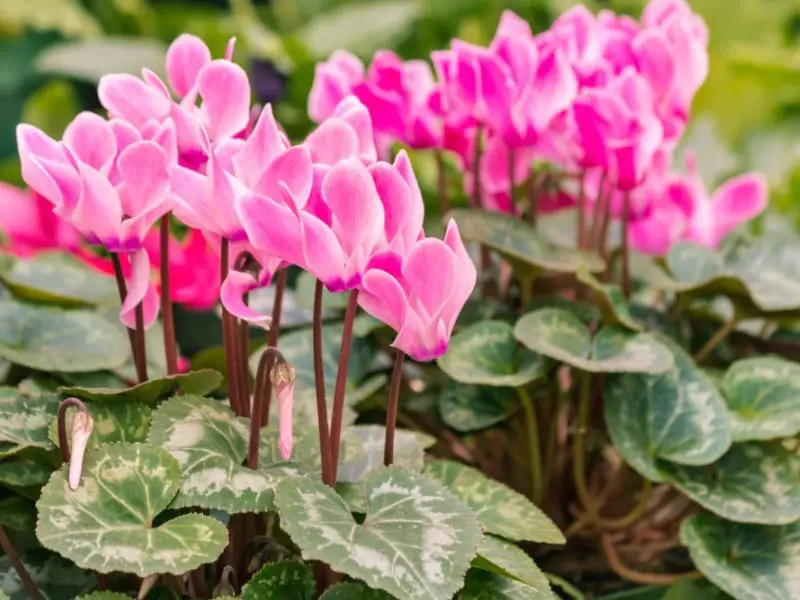Cyclamen is a winter-blooming plant loved for its graceful flowers and patterned heart-shaped leaves. When most of the garden rests, cyclamen comes alive with shades of pink, red, white, and purple, bringing beauty and elegance to cold days. Its unique charm makes it a favorite for both indoor pots and shady garden beds, turning dull corners into vibrant spaces.
Learning how to plant cyclamen is the key to lasting success. Proper soil, light, and timing ensure the plant thrives through winter and returns each year. Beyond its beauty, cyclamen carries a touch of symbolism, often seen as a sign of sincere love and devotion. With the right planting approach, this delightful flower becomes a stunning focal point, keeping your garden colorful even in the heart of winter.
Understanding Cyclamen Varieties

Cyclamen is not a single plant but a diverse group with many species and cultivars. Each variety offers unique colors, bloom times, and growth habits. The most commonly grown type is Cyclamen persicum, often called the florist’s cyclamen, which is prized for its large, showy flowers and broad range of colors. This variety is widely available in garden centers, especially during the holiday season, and is perfect for indoor displays. Its blooms can last for weeks, making it an excellent choice for winter decoration.
Hardy cyclamen, such as Cyclamen hederifolium and Cyclamen coum, thrive outdoors in cooler climates. They produce smaller but equally charming flowers and can naturalize in woodland gardens or shady beds. These varieties are known for their resilience, often surviving frost and returning year after year with minimal care. Their patterned leaves add extra beauty even when the plant is not in bloom. Gardeners who want long-term results often choose hardy types because they offer both flowers and foliage through different seasons.
Modern hybrid cyclamen provide even more options for gardeners. Breeders have developed compact forms, fringed petals, and unique color blends to suit different tastes. Some hybrids are specially designed for indoor environments, thriving in containers on windowsills or tables. Others are created for outdoor use, handling varying conditions with ease. By exploring the different varieties, you can choose the cyclamen that best matches your garden style and growing conditions. Understanding these differences ensures that when you plant cyclamen, you select the right type for lasting beauty in your winter garden.
Choosing the Right Location for Cyclamen
Selecting the proper location is one of the most important steps when planting cyclamen. These plants naturally grow in cool, shaded areas, which means they do not perform well in hot or direct sunlight. If you are planting outdoors, a partially shaded spot under trees or along the north side of a building works best. Indoors, they thrive near bright windows with filtered light but should be kept away from heating vents and direct sun that can scorch their leaves. The right location not only extends the blooming season but also preserves the decorative beauty of the foliage.
Temperature is another critical factor to consider. Cyclamen prefer cooler conditions, ideally between 50 and 65 degrees Fahrenheit. Placing them in warm or dry spots can cause the plant to go dormant earlier than expected and reduce flower production. In outdoor gardens, it is best to choose areas that remain cool throughout the day, even in full winter sun. For indoor growth, avoid south-facing windows where midday sun raises the temperature. Instead, east-facing or north-facing locations provide a gentle balance of light and air, encouraging healthy, steady growth.
Moisture and air circulation also play an essential role in choosing the right spot. Cyclamen dislike overly damp or stagnant conditions, which can encourage bulb and root rot. Well-drained soil outdoors and breathable pots indoors help prevent water from pooling around the bulbs. A location with steady but gentle airflow reduces the risk of fungal problems while maintaining leaf freshness. When all these conditions come together—shade, cool air, and balanced moisture—cyclamen flourish beautifully and reward you with long-lasting winter blooms.
Soil Preparation for Healthy Cyclamen Growth
Cyclamen bulbs, also called tubers, need well-prepared soil to thrive. Unlike many flowering plants, they dislike heavy or compacted ground where water lingers. The ideal soil for cyclamen is light, airy, and fast-draining, with a slightly acidic to neutral pH between 6.0 and 7.0. This ensures that excess water flows away quickly while the roots still have access to enough moisture. Preparing soil correctly at the start makes a significant difference in how well cyclamen grow and how long their blooms last.
To create the right foundation, mix organic matter such as compost, leaf mold, or peat moss into the soil before planting. These materials improve drainage while enriching the ground with nutrients. Adding a small amount of coarse sand or perlite can further enhance soil texture, preventing the tubers from sitting in soggy conditions. Gardeners planting cyclamen in containers should always choose a high-quality potting mix labeled for good drainage. Using garden soil alone in pots is not recommended because it can become compact and retain too much water.
It is also helpful to prepare the planting bed a few weeks in advance. This allows amendments to settle and creates a stable environment for the tubers. Raised beds or mounded areas work especially well for outdoor plantings in regions with heavy clay soils. When planting indoors, select pots with ample drainage holes to reduce the risk of root diseases. Proper soil preparation not only supports healthy growth but also reduces common problems like wilting, yellowing leaves, or bulb rot. With the right soil, cyclamen reward you with vigorous foliage and spectacular winter flowers.
When to Plant Cyclamen Bulbs for Best Results
Timing is a key factor in the successful growth of cyclamen. These plants have a natural rhythm that differs from many other flowering species. Cyclamen bulbs, or tubers, are best planted in the fall, typically between September and November, depending on your local climate. Planting in this cooler period gives the tubers time to establish strong roots before the onset of winter. By the time the holiday season arrives, the plants are ready to produce their striking flowers.
In regions with mild winters, outdoor planting in autumn ensures that cyclamen bloom steadily throughout the colder months. Gardeners in colder zones can also enjoy success by planting in containers and keeping them in sheltered but cool spaces. The important thing is to avoid planting during hot summer conditions, as cyclamen bulbs naturally enter dormancy at that time. Trying to force them into growth in the wrong season often leads to weak plants and disappointing blooms. Aligning your planting with their natural cycle sets the stage for healthier growth.
Indoor growers should also follow the same seasonal schedule. Starting bulbs in pots during fall allows them to settle into their new environment and begin leaf growth. By winter, the plants will already be flourishing and ready to brighten indoor spaces. Planning ahead is essential, as cyclamen do not respond well to rushed planting or sudden changes in temperature. By choosing the right season, you encourage your plants to thrive, giving you a long-lasting display of elegant flowers exactly when your garden or home needs them most.
Planting Depth and Spacing Guidelines for Cyclamen
Proper Planting Depth for Cyclamen
Planting depth plays a crucial role in ensuring cyclamen grow strong and healthy. For most cyclamen, the tubers should be placed just below the soil surface, with the top slightly exposed to prevent rotting. If planted too deeply, the tuber may stay too wet and struggle to sprout leaves and flowers. On the other hand, leaving it too shallow can cause the tuber to dry out or become unstable. A depth of about 1 to 2 inches is generally ideal, though hardy varieties can tolerate being planted a little deeper.
The soil should be light and well-drained to avoid waterlogging, which is the most common cause of tuber damage. Gardeners often add sand, grit, or compost to improve aeration and drainage. Once placed at the right depth, cover gently with soil without compacting it too tightly. This balance helps the roots establish themselves quickly while keeping the tuber safe from excessive moisture. Correct planting depth not only encourages strong flowering but also prolongs the plant’s overall lifespan.
Spacing for Healthy Growth
Proper spacing is just as important as depth when planting cyclamen. Crowding the plants too closely together can restrict airflow and increase the risk of fungal diseases, especially in damp conditions. Each tuber should be planted about 6 to 8 inches apart, giving them enough room to expand naturally. This spacing ensures that the roots have adequate space to grow and that the foliage can spread out without competition. For larger outdoor displays, spacing them evenly also creates a more balanced and visually appealing effect.
Indoors, cyclamen grown in pots should also have enough space between tubers if multiple are planted in one container. Good spacing reduces the risk of water pooling around the crowns, which can lead to rot. It also allows each plant to receive sufficient light, helping flowers develop more evenly. By providing room to breathe, cyclamen are less stressed and more resilient, rewarding gardeners with longer-lasting blooms. Careful spacing combined with the right planting depth is the key to establishing vibrant, healthy cyclamen plants.
Watering Techniques for Cyclamen Success
Watering cyclamen correctly can make the difference between a thriving plant and one that struggles. These delicate plants prefer consistent but moderate moisture, which means the soil should never be waterlogged or completely dry. Overwatering is the most common mistake and often leads to tuber rot, while underwatering can cause leaves to wilt and flowers to fade quickly. The best approach is to water when the top inch of soil feels slightly dry, keeping a steady balance of moisture without drowning the roots.
The way you water cyclamen is just as important as how often. Instead of pouring water directly over the crown of the plant, which increases the risk of rot, it is better to water around the edges of the pot or the soil surface. Some gardeners prefer bottom watering, placing the pot in a shallow tray of water and allowing the soil to absorb moisture naturally. This method helps keep the crown dry and reduces fungal problems while ensuring the roots receive even hydration.
Cyclamen also have seasonal watering needs. During their active growing and blooming phase in the cooler months, they require regular moisture to support healthy foliage and flowers. However, when the plant enters dormancy in warmer seasons, watering should be reduced significantly. At this stage, giving just enough water to prevent the tuber from shriveling is enough. Understanding these cycles and adjusting watering habits accordingly ensures cyclamen remain healthy year after year, rewarding you with vibrant winter blooms.
Fertilizing Cyclamen for Optimal Blooms
Proper fertilization is essential for keeping cyclamen healthy and producing vibrant flowers throughout the winter months. Cyclamen are not heavy feeders, but they benefit from a balanced fertilizer that provides the nutrients necessary for strong roots, lush foliage, and abundant blooms. Using a water-soluble fertilizer with equal parts nitrogen, phosphorus, and potassium is ideal. Apply the fertilizer every two to four weeks during the active growth period, taking care not to over-fertilize, which can burn the roots and damage the tuber.
Timing and technique are important when fertilizing cyclamen. Fertilizer should be applied when the plant is actively growing, typically during cooler months. Avoid applying fertilizer to dormant tubers, as this can stress the plant and cause poor results. It is best to mix the fertilizer with water and apply it directly to the soil, rather than on the leaves or crown, to reduce the risk of leaf burn and fungal problems. Regular feeding encourages more blooms, stronger stems, and healthier foliage, allowing the plant to reach its full aesthetic potential.
In addition to chemical fertilizers, organic options can also benefit cyclamen. Well-composted materials, fish emulsion, or liquid seaweed extracts provide gentle nutrients that support long-term soil health and encourage natural growth cycles. These organic alternatives reduce the risk of overfeeding and promote a healthier root system. Combining proper timing, careful application, and high-quality nutrients ensures cyclamen thrive in both indoor and outdoor settings, rewarding gardeners with dazzling, long-lasting winter blooms that brighten any space.
Pruning and Deadheading for Continued Flowering
Pruning Cyclamen for Healthy Growth
Pruning is an essential practice to maintain cyclamen’s health and encourage strong growth. Removing yellowed or damaged leaves prevents the plant from wasting energy on decaying foliage. It also improves air circulation around the tuber, reducing the risk of fungal infections. Gardeners should prune leaves by gently twisting and pulling them away from the base or using clean scissors to cut them close to the crown. Regular pruning keeps the plant tidy and allows sunlight to reach the healthy leaves, supporting continued photosynthesis and overall vigor.
Pruning is especially important after the flowering period. Once the blooms fade, removing spent flowers not only improves appearance but also redirects the plant’s energy toward new growth and tuber development. Avoid cutting too close to the crown, as this can damage the growing points. Consistent pruning encourages a more compact and bushy plant, resulting in stronger stems and more abundant blooms in the following season. By combining careful leaf and stem pruning, cyclamen maintain a healthy, attractive form throughout their growing cycle.
Deadheading Cyclamen for Extended Blooms
Deadheading, or removing faded flowers, plays a critical role in prolonging cyclamen’s blooming period. When old flowers are left to wither on the plant, they divert energy away from new buds and can attract pests or diseases. To deadhead properly, grasp the flower stem at its base and gently twist or cut it off. This technique ensures the plant can focus on producing fresh blooms rather than seed development, maximizing the visual display.
Consistent deadheading also helps maintain a neat and attractive plant. Flowers emerge more evenly when old blooms are removed promptly, creating a fuller and brighter appearance. For indoor plants, this practice keeps cyclamen looking fresh on tables and windowsills throughout the winter. Outdoor cyclamen benefit as well, with healthier growth and improved flower density. By integrating deadheading into regular care, gardeners encourage continuous flowering, ensuring cyclamen remain a highlight of any winter garden.
Pest and Disease Management for Cyclamen
Preventing Pests in Cyclamen
Cyclamen are susceptible to a variety of pests, including aphids, spider mites, and cyclamen mites, which can damage both foliage and flowers. Aphids and spider mites feed on the leaves, causing yellowing, curling, or speckled patterns, while cyclamen mites are particularly harmful to new growth and buds. Early detection is essential for keeping infestations under control. Regularly inspect your plants for signs of damage or unusual leaf patterns. Removing affected leaves promptly and isolating infested plants helps prevent pests from spreading to healthy cyclamen.
Using preventive measures, such as maintaining proper spacing between plants and ensuring good airflow, reduces the likelihood of pest problems. Natural remedies like neem oil or insecticidal soap can control minor infestations without harming the plant. Additionally, keeping the environment clean and free of fallen leaves or debris minimizes hiding spots for pests. By combining regular monitoring with proactive care, gardeners can keep cyclamen healthy and vibrant, ensuring continuous flowering throughout the season.
Preventing Diseases in Cyclamen
Fungal and bacterial diseases pose a significant threat to cyclamen, particularly when plants are overwatered or grown in poorly drained soil. Gray mold, caused by Botrytis, can appear on flowers and leaves, while tuber rot from Fusarium or Pythium may completely destroy the plant. To prevent disease, ensure the soil drains well, avoid watering directly on the crown, and provide adequate airflow around each plant. Using clean tools and pots when planting or pruning reduces the risk of spreading pathogens.
Proper environmental management also strengthens the plant’s natural defenses. Avoid overcrowding cyclamen, as tight spacing increases humidity and creates a favorable environment for fungal growth. Maintaining appropriate light, temperature, and moisture levels keeps plants stress-free and more resistant to disease. By integrating preventive practices with attentive care, gardeners can significantly reduce the risk of pests and diseases, ensuring cyclamen remain healthy, vibrant, and capable of producing long-lasting blooms year after year.
Overwintering Cyclamen for Year-Round Success
Proper overwintering is crucial for cyclamen to thrive year after year. These plants have a natural dormancy period during warmer months, usually after the flowering season ends. During this time, the leaves begin to yellow and die back, signaling that the tuber needs rest. Understanding this cycle allows gardeners to provide the right care to ensure the plant survives and returns strong in the next season. Cyclamen stored improperly may fail to bloom again, so attention to temperature, moisture, and light is essential.
For outdoor cyclamen in colder climates, overwintering often requires protection from frost and excessive moisture. Mulching with dry leaves or straw can insulate the tubers, while raised beds or well-drained soil prevent waterlogging that can lead to rot. In extremely cold areas, digging up the tubers and storing them indoors in a cool, dark, and dry environment is a safe alternative. This method ensures that the tubers remain dormant without drying out completely, allowing them to re-sprout when conditions are favorable.
Indoor cyclamen also need a dormancy period, though they are less exposed to extreme weather. Once leaves start to fade, reduce watering gradually and place the plant in a cooler location with minimal light. Avoid fertilizing during dormancy, as the plant is not actively growing. After a few months, new shoots will begin to emerge, signaling that it is time to resume regular care, including watering and light exposure. Proper overwintering guarantees that cyclamen will provide vibrant blooms and healthy foliage, year after year.
Dividing and Propagating Cyclamen for More Blooms
Dividing Cyclamen for Garden Expansion
Dividing cyclamen is an effective way to increase the number of plants in your garden. Mature clumps of cyclamen tubers naturally expand over time, producing offsets that can be separated and replanted. The best time for division is during the plant’s dormancy period, usually in late summer when the leaves have died back. Carefully lift the tubers from the soil, gently removing excess dirt, and identify individual offsets that have their own roots. Each separated tuber can become a new, independent plant ready to produce blooms in the next season.
Handling the tubers with care is essential to prevent damage. Avoid cutting or bruising the tubers, as injuries can lead to rot or disease. Once divided, allow the tubers to dry for a few hours in a shaded area before replanting in well-drained soil. Proper spacing and depth, combined with gentle watering after planting, help the new divisions establish quickly. By dividing cyclamen correctly, gardeners can expand their collection while maintaining healthy, vigorous plants that continue to produce stunning winter flowers.
Propagating Cyclamen from Seeds
Propagation from seeds is another method to increase cyclamen plants, though it requires patience and careful attention. Seed-grown cyclamen often produce unique variations in flower color and leaf patterns, making them especially appealing to gardeners who enjoy diversity. Sow seeds in a well-draining, nutrient-rich medium during the plant’s dormant period. Cover lightly and keep the soil consistently moist while providing a cool environment to encourage germination. Seedlings typically take several months to develop into mature flowering plants, but the results are rewarding.
Maintaining proper conditions during germination is critical for success. Avoid exposing seeds to direct sunlight, which can dry out the soil or overheat delicate seedlings. Consistent humidity and temperature control foster strong root development and healthy foliage. Once seedlings are large enough to handle, they can be transplanted into individual pots or prepared garden beds. Propagating cyclamen from seeds allows gardeners to cultivate a wide variety of colors and forms, ensuring long-term enjoyment and a continually refreshed display of winter blooms.
FAQ for Growing Cyclamen Successfully
When is the best time to plant cyclamen bulbs?
The best time to plant cyclamen bulbs is during their dormant period, usually in early fall. This timing allows the tubers to establish roots before winter, ensuring strong growth and vibrant blooms during the cooler months. Avoid planting during hot summer periods to prevent stress and poor development.
How much sunlight do cyclamen need?
Cyclamen thrive in bright, indirect light. Outdoors, a partially shaded spot under trees or near buildings works well, while indoors, place them near windows with filtered light. Direct sunlight can scorch leaves, whereas too little light can reduce flowering. Proper light encourages healthy growth and prolonged blooms.
How should I water cyclamen?
Water cyclamen moderately, keeping the soil slightly moist but never waterlogged. Avoid watering directly on the tuber crown, which can cause rot. Bottom watering or watering around the edges is ideal. Reduce watering during dormancy to prevent tuber shriveling and resume regular care once new growth appears.
How can I prevent pests and diseases?
Regular inspection, proper spacing, good airflow, and clean tools help prevent pests and diseases. Treat minor infestations with neem oil or insecticidal soap. Avoid overwatering and ensure well-draining soil to prevent fungal infections. Healthy, stress-free plants are naturally more resistant to problems.
Can cyclamen be propagated for more blooms?
Yes, cyclamen can be propagated by dividing mature tubers or growing from seeds. Dividing is best during dormancy, while seeds require patience as seedlings take months to flower. Proper care, spacing, and soil preparation ensure successful propagation and long-term blooms.
Conclusion
Cyclamen are truly remarkable plants that bring vibrant color and elegance to winter gardens and indoor spaces. By understanding their unique growth cycle, providing proper soil, light, and watering, and practicing regular pruning and deadheading, gardeners can enjoy long-lasting blooms year after year. Propagation and preventive care further enhance plant health and floral displays. Whether grown indoors or outdoors, cyclamen reward attentive care with stunning flowers and attractive foliage. Mastering these essential techniques ensures a thriving, beautiful display, making cyclamen a cherished addition to any garden or home throughout the colder months.






